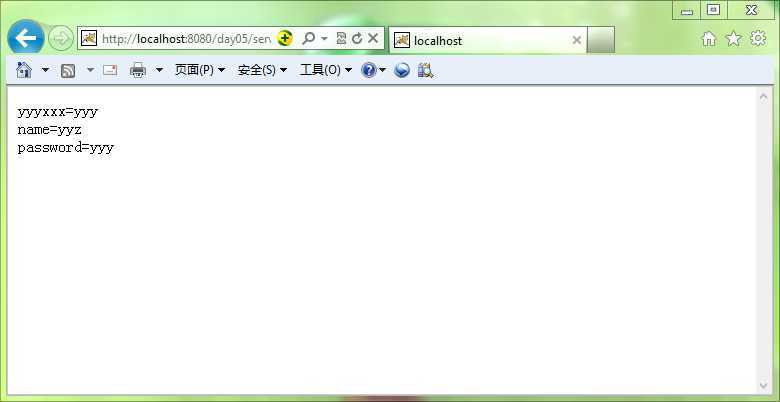标签:style blog http color io os ar 使用 java
1 1 package com.yyz.servletconfig; 2 2 3 3 import java.io.IOException; 4 4 import java.util.Enumeration; 5 5 6 6 import javax.servlet.ServletConfig; 7 7 import javax.servlet.ServletException; 8 8 import javax.servlet.http.HttpServlet; 9 9 import javax.servlet.http.HttpServletRequest; 10 10 import javax.servlet.http.HttpServletResponse; 11 11 12 12 public class ServletConfigDemo1 extends HttpServlet { 13 13 14 14 15 15 16 16 ServletConfig config; 17 17 public void doGet(HttpServletRequest request, HttpServletResponse response) 18 18 throws ServletException, IOException { 19 19 //获取指定的初始化参数 20 20 String value = config.getInitParameter("xxx"); 21 21 response.getOutputStream().write(value.getBytes()); 22 22 //获取所有的初始化参数 23 23 Enumeration e = cofig.getInitParameterNames(); 24 24 while(e.hasMoreElements()){ 25 25 String name = (String) e.nextElement(); 26 26 value = config.getInitParameter(name); 27 27 response.getOutputStream().write((name+"="+value+"<br/>").getBytes()); 28 28 } 29 29 } 30 30 31 31 32 32 public void doPost(HttpServletRequest request, HttpServletResponse response) 33 33 throws ServletException, IOException { 34 34 doGet(request,response); 35 35 36 36 37 37 } 38 38 39 39 40 40 @Override 41 41 public void init(ServletConfig config) throws ServletException { 42 42 this.config = config; 43 43 } 44 44 45 45 }
相应的web.xml如下:
1 <?xml version="1.0" encoding="UTF-8"?> 2 3 <web-app xmlns="http://java.sun.com/xml/ns/javaee" 4 xmlns:xsi="http://www.w3.org/2001/XMLSchema-instance" 5 xsi:schemaLocation="http://java.sun.com/xml/ns/javaee http://java.sun.com/xml/ns/javaee/web-app_2_5.xsd" 6 version="2.5"> 7 <servlet> 8 9 <servlet-name>ServletConfigDemo1</servlet-name> 10 <servlet-class>com.yyz.servletconfig.ServletConfigDemo1</servlet-class> 11 <init-param> 12 <param-name>xxx</param-name> 13 <param-value>yyy</param-value> 14 </init-param> 15 <init-param> 16 <param-name>name</param-name> 17 <param-value>yyz</param-value> 18 </init-param> 19 <init-param> 20 <param-name>password</param-name> 21 <param-value>yyy</param-value> 22 </init-param> 23 </servlet> 24 <servlet-mapping> 25 <servlet-name>ServletConfigDemo1</servlet-name> 26 <url-pattern>/servlet/ServletConfigDemo1</url-pattern> 27 28 </servlet-mapping> 29 </web-app>
测试结果如下:

在上面的代码中,ServletConfigDemo1对象中有一个ServletConfig对象,其实这是不必要的。因为ServletConfigDemo1继承了HttpServlet,HttpServlet又继承了GenericServlet 。GenericServlet 已经在内部维护了一个ServletConfig对象。相关实现如下:
1 public abstract class GenericServlet 2 implements Servlet, ServletConfig, java.io.Serializable 3 { 4 … … 5 private transient ServletConfig config; 6 public ServletConfig getServletConfig() { 7 return config; 8 } 9 }
因而我们可以通过我们写的Servlet对象的getServletConfig()方法直接拿到ServletConfig对象,示例代码如下:
1 1 package com.yyz.servletconfig; 2 2 3 3 import java.io.IOException; 4 4 import java.io.PrintWriter; 5 5 6 6 import javax.servlet.ServletException; 7 7 import javax.servlet.http.HttpServlet; 8 8 import javax.servlet.http.HttpServletRequest; 9 9 import javax.servlet.http.HttpServletResponse; 10 10 11 11 public class ServletConfigDemo2 extends HttpServlet { 12 12 13 13 public void doGet(HttpServletRequest request, HttpServletResponse response) 14 14 throws ServletException, IOException { 15 15 16 16 String value = this.getServletConfig().getInitParameter("name"); 17 17 System.out.println(value); 18 18 } 19 19 20 20 public void doPost(HttpServletRequest request, HttpServletResponse response) 21 21 throws ServletException, IOException { 22 22 23 23 doGet(request, response); 24 24 } 25 25 26 26 }
web.xml文件:
<?xml version="1.0" encoding="UTF-8"?> <web-app xmlns="http://java.sun.com/xml/ns/javaee" xmlns:xsi="http://www.w3.org/2001/XMLSchema-instance" xsi:schemaLocation="http://java.sun.com/xml/ns/javaee http://java.sun.com/xml/ns/javaee/web-app_2_5.xsd" version="2.5"> <servlet> <servlet-name>ServletConfigDemo2</servlet-name> <servlet-class>com.yyz.servletconfig.ServletConfigDemo2</servlet-class> <init-param> <param-name>name</param-name> <param-value>yyz</param-value> </init-param> </servlet> <servlet-mapping> <servlet-name>ServletConfigDemo2</servlet-name> <url-pattern>/servlet/ServletConfigDemo2</url-pattern> </servlet-mapping> </web-app>
标签:style blog http color io os ar 使用 java
原文地址:http://www.cnblogs.com/yyz666/p/4042101.html